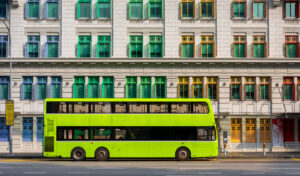Resource Hub
How to create a successful public transport service with a franchise model
Published December 21, 2023 in Blog
Cities around the world are looking at congestion-busting incentives for residents to leave their private vehicles at home and use public transport for their daily commute. However, for this to occur, public transport needs to be an appealing option – with regular, reliable, affordable, convenient, and safe services.
Transport authorities need cost-effective options to move thousands of people quickly around cities every day. Regardless of whether buses, trams, commuter rail, or ferries are part of the public transport mix, any system requires careful planning and operation to enable widespread acceptance by locals and visitors alike. ‘Franchise models’ are becoming a popular means to achieve this outcome.
This blog examines:
- How successful public transport services can be delivered using a franchise model
- How technology enables transport authorities to manage franchise models
- How operators within a franchise model provide high-quality public transport services that are good value for taxpayers’ money and deliver great passenger experiences
What is the ‘Franchise Model?’
A franchise model is a change of thinking from conventional public transport services. Traditionally, services have been founded on an operator-led, revenue-based, service delivery model. A franchise model is quite different – where operators contract to a central transport authority to deliver services to a pre-defined quality level.
It is set up in a way where the transport authority determines the routes, fare structures, and incentives to ensure a successful public transport service is delivered [1]. This is part of a global trend where there is a clear separation between the transport authority that develops and oversees the public transport system, and the operator(s) that deliver passenger services.[2].
The Transport Authority and Operator Relationship
With the franchising approach, the transport authority’s role is to specify what it wants the market to deliver with the available funds and provides the (fair) conditions for operators to achieve this outcome. However, the services themselves are provided by independent operators who are contracted via competitive tender by the transport authority.
Operators have expertise at managing large bus, tram, or ferry fleets, and employ the qualified staff required to operate and maintain them. It is up to each operator to deliver services that meet passenger needs – which in turn contributes to the wider transport authority objectives. In effect, the franchise model allows these operators to use their strength in operations to deliver great services.

The transport authority develops contracts with operators to ensure they deliver services that meet their objectives and quality criteria. For example, as part of a contract, an operator may need to meet a service interval of every 10 minutes at each station on a particular route. If an operator meets this target, they are incentivised with financial rewards. If they fail, they are penalised.
If services are affected by circumstances outside the operator’s control, such as diversions, road closures, and other disruptions, the contracting model normally includes a mechanism to recognise the service delivered without financial penalty. The franchise system aims to encourage competition that keeps costs down, while rewarding good operators and removing underperforming ones.
How Many Operators are Usually Involved?
By definition, a franchise model involves multiple operators. While some transport systems only have one operator[3], ideally two or more operators are contracted to reduce transport authority risks.
Initial advantages of using a single operator, such as simplified implementations and the transport authority not having to build their capacity to manage multiple operators, are outweighed by a lack of leverage for the transport authority to control what the operator does if service levels are unsatisfactory. In effect, a single operator creates a monopoly, and is not subject to competitive forces that drive efficiencies and control costs.
Who has Implemented the Franchise Model?
Many cities have successfully implemented the franchise model – including small to large authorities with varying transit budgets. Transport for London (TfL) (including buses and trams, with over 10 operators) and the Singapore Land Transport Authority (LTA) (4 operators) have successfully run franchise models for many years, supporting service improvements and increased passenger satisfaction.

For example, since Singapore fully transitioned to the franchise model, there has been less crowding on buses, less wait time, more services deployed, and more staff employed [4]. Other examples where franchise models have worked well include NTA Ireland, Sydney, and Cape Town.
There are also variations within franchise models. In Singapore, buses and depots are owned by the LTA, and bus operators are contracted to operate the network by using and maintaining these assets. In London, the depots and the buses/trams are owned by the operators.
While a franchise model may not be suitable for all cities, it does enable the organisation of transport services within a competitive market that incentivises operators to provide quality, value-for-money public transport services. Usually, there is a transition process towards the franchise model e.g., the Singapore franchise model commenced in 2014 with only two operators, while two more have been subsequently introduced into the network. With any franchise model, the number of operators can fluctuate between contract cycles and changing public transport requirements.
How to Run a Franchise Model Successfully with Technology
Regardless of the model adopted, the main aim of a public transport system is to provide reliable services at convenient, regular intervals. For a franchise model to work effectively, technology is required to monitor the actual service intervals against the operators’ contracts.
At the same time, operators require information to manage services and help them meet their contractual obligations. Achieving these outcomes requires a unified system that shows the transport authority and operators exactly what is always happening throughout the entire public transport network.
How Intelligent Transport Systems Help
If a transport authority uses the franchise model, they will need to know how well operators are delivering their services. Transport authorities will also want to improve efficiencies and service quality.
Intelligent Transport Systems (ITS) technology helps achieve this aim by connecting all the moving parts of a public transport network into a central place. ITS collects operational information from multiple operators for detailed analysis – which means a transport authority can monitor all services to make sure they are being delivered to the required benchmarks and KPIs [5].
The Singapore LTA use ITS to track every single bus (over 6,000 vehicles) throughout the country, which involves multiple routes and operators. This gives the LTA a consistent and reliable way to monitor contracted services. As the ITS is provided by the LTA, it provides a ‘single source of truth’ of data across the entire bus network, which means there is a central reference for performance measurement.
ITS involves fitting a GPS tracker and displays to every vehicle and informing both the control room and driver about each service. Because information generation happens in real-time, the operator can improve services while they are running. ITS also provides data to help improve decision making within the transport authority. During daily operations, the system collects operational data which is automatically analysed to show the punctuality of individual vehicles, as well as information on specific problem areas. Data analysis shows potential trouble spots along with operational procedures.
Statistical applications make the operational process more transparent for both the transport authority and the operator. The transport authority can introduce suitable changes, based on accurate results – which allows for the ongoing optimisation of operational processes and performance. One change might be adjusting bus and tram priority settings or timetabled travel times between stops. Most importantly when it comes to the franchise model, payments need to be made based on the actual services delivered – and such payments need to be made on measurements that reflect the operator contract.
The system needs to be scalable so that franchises and operators can be added or removed. Trapeze has helped implement ITS for large global cities like London and Singapore and has also helped other cities achieve their similar goals on a smaller scale.
How Transport for London uses ITS
To find out more on how Trapeze’s ITS technology can be applied to the franchise model, see our video on how Transport for London uses ITS to manage multiple operators. TfL’s ITS system is used to help transport over seven million bus and tram passengers daily, and their franchise model has supported the delivery of excellent public transport services that are well received by commuters [6].
Conclusion
Overall, the franchise approach can provide flexibility for transport authorities to influence market outcomes. When a franchise model performs well, it provides transport authorities and operators with a framework to provide quality public transport services that are good value for public funds.
ITS supports the franchise model by providing a consistent, accurate, single source of truth data that allows the transport authority and operators to manage service delivery against contracts, as well as increasing service reliability and the passenger experience.
Trapeze brings a wealth of experience, based on the implementation and support of more than 100 ITS systems worldwide for transport authorities and operators across multiple transport modes – including those that leverage a franchised model.
Find out more at our pages on bus, light rail, and ferry Intelligent Transport Systems.
Contact Us to find out more about how Trapeze technology can help improve public transport operations.
References
[1] Urban Transport Group, “Bus Franchising”, [Online]. Available: https://www.urbantransportgroup.org/system/files/general-docs/Bus%20franchising%20briefing.pdf
[2] UITP Australia/New Zealand. Frameworks for our networks: A review of public transport service contracts in Australia and New Zealand. February 2021. [Online]. Available: https://cms.uitp.org/wp/wp-content/uploads/2021/02/FINAL-UITPANZ-Allens-Report-Frameworks-for-our-Networks-February-2021.pdf
[3] Far East Mobility, “BRT Planning Risks: What Could Possibly Go Wrong?”, 1 September 2017. [Online]. Available: https://www.fareast.mobi/en/brt/risks/BRT-Project-Risks-What-Could-Possibly-Go-Wrong
[4] Singapore Land and Transport Authority, “Bus Services Continue to Improve Since Transition to BCM,” 04 09 2017. [Online]. Available: https://www.lta.gov.sg/content/ltagov/en/newsroom/2017/9/2/bus-services-continue-to-improve-since-transition-to-bcm.html
[5] Transport Network, “Taking the Franchise Route”, 17 November 2020. [Online]. Available: https://www.transport-network.co.uk/Taking-the-Franchise-Route/16402
[6] Intelligent Transport, “Technology-backed franchising: the model for a better bus sector”, 17 November 2020. [Online]. Available: https://www.intelligenttransport.com/transport-articles/111630/technology-backed-franchising-the-model-for-a-better-bus-sector/
Mode of Transport
Bus
Solutions
Intelligent Transport Systems